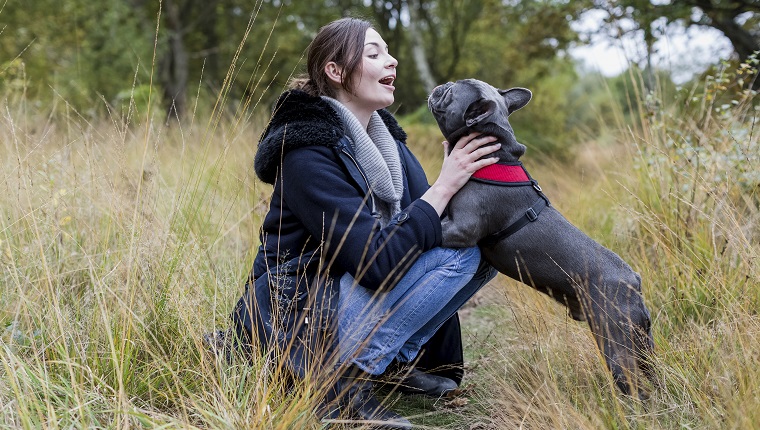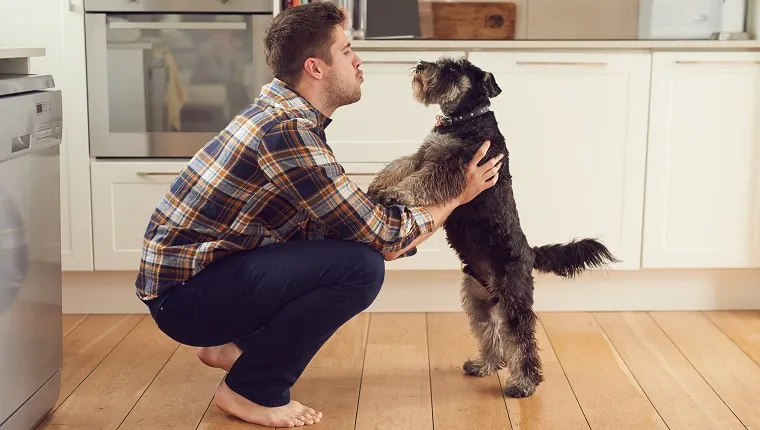Most dog owners talk to their animals often, but do they like it? While dogs can understand some words, you might wonder if they get anything out of conversations they can’t understand.
Any dog parent can tell you that their dog prefers baby talk to stern words and yelling. But do dogs enjoy being talked to like babies, and do they benefit from such speech? How do dogs like for us to talk to them?
Why do we talk to dogs like babies?
When we raise the pitch of our voices and simplify our language to address our pooches, it’s called “dog-directed speech.” It’s very similar to the way that we talk to babies.
Research suggests that human babies do benefit from this type of speech. It seems to capture their attention more easily and improve their focus on the speaker’s words.
Babies who are spoken to in baby-directed speech tend to start mimicking vowel sounds and develop a vocabulary more quickly.
If the same were true for puppies and dogs, we’d likely see that dog-directed speech would hold their attention and improve their understanding more so than the normal speaking voice we use when addressing other adult humans.
Does the science back up that claim?
Is talking to dogs beneficial?

Research published in the journal Proceedings of the Royal Society B shows that dog-directed speech does, in fact, help puppies pay more attention to the humans who are talking to them.
Researchers played several different recordings of humans using different tones to say the same phrase and found that puppies responded most to the high-pitched, dog-directed tone than other recordings.
This is useful to know, as it can help those who wish to train a puppy to follow commands.
Further research from the University of York shows that dogs of any age are more responsive to dog-directed speech. The experiment also showed that it didn’t just matter how humans said things, but what they said made a difference, too.
For this study, researchers had humans say common conversational phrases, like “I went to the cinema last night,” to dogs in a normal voice and a dog-directed tone. Dogs responded more positively to the dog-directed tone.
Then the researchers had humans say common conversational phrases in a dog- directed tone, then speak in the same tone with dog-related content and words. The dogs responded to the dog-related content most.
So it doesn’t just matter how we say things. Dogs at least have some idea of what we are saying, too.
They respond best when humans combine dog-directed speech with dog-related content. They want to spend time with humans who speak that way the most.
Does talking to my dog make it feel closer to me?
Being able to communicate with your dog is the foundation for strengthening your bond. It’s very beneficial for training purposes and expressing your desires to your pup.
Dogs are good at understanding humans. They can read our emotions, follow our instructions, and anticipate our wants. It’s one of the many reasons we love them so much.
As the research shows, speaking to dogs in dog-directed speech really does make them want to spend more time with us, and that’s a good thing.
Dogs are also good at associating your tone with your actions. When you speak to them in cheerful dog-directed speech, they probably know that affection and rewards will soon follow. When you’re stern, they know that you may be rebuking them for their behavior.
The next time you speak to your dog, imagine it from their perspective. What associations have they formed with your speech and your words? Do they know the word “vet?” How about “bath?” Do they know “walk” or “treat?”
Knowing how your dog reacts to your tone and words can help you give them comfort when things are frightening or when they get anxious. It can also help you share in their joy and excitement.
How does non-verbal communication affect dogs?

With all the research and personal experiences we have when it comes to speaking to our dogs, we might start to underestimate the importance of non-verbal communication.
When you think about it, there are deaf dogs and deaf humans who do not rely on speech to communicate with one another, yet they still have bonds that are just as strong as humans and dogs who do depend on speech.
Dogs can understand sign language just as well as spoken language — sometimes even more easily. Is there a signed version of dog-directed speech that helps dogs pay more attention and strengthens their bond with humans?
I couldn’t find any studies that even ask that question, but it’s certainly something to think about, as it could have implications for the way we communicate to our dogs non-verbally.
Dogs also use non-verbal communication to find out how we’re feeling. They can smell the chemicals we release when we are sick, healthy, happy, anxious, excited, and more. They can learn to follow our body language and respond accordingly, just the same as they do for speech.
In fact, one must wonder how much of dogs’ response to our speech is a reaction to the speech itself and how much of it is learned through associations. Could a dog learn to love being yelled at if it was always followed by affection and treats? Who knows?
In the end, it isn’t of much consequence because dogs like what they like, whether it’s learned or innate. But asking that kind of question can help us further explore how we can most effectively communicate with our dogs and strengthen our relationships.
When it comes down to it, non-verbal communication may be far more significant than verbal communication.
Research published in the journal Physiology and Behavior looked at how dogs responded to greetings after being left alone for a period of time. Humans would either greet the dog with petting and verbal praise, just greet with verbal praise, or not greet the dog at all.
Levels of oxytocin, the “love hormone,” were highest in dogs who got both pets and praise.
So clearly, verbal communication is not the only key to making our dogs happy. We need to communicate in many ways to form relationships with our pups.
How does my dog talk back to me?
Much of this article has been about the ways we communicate to dogs, but communication is a two-way street. We owe it to our dogs to learn how they talk back, as well.
Dogs use their own verbal cues through vocalizations, but they also rely on body language.
Sometimes our understanding of our dogs comes about naturally. For example, you can probably tell the difference between your dog begging to go out for a potty break versus your dog begging for food.
Eventually, you spend enough time around each other to form an understanding without thinking about it.
That’s a great, natural way to communicate with your pup, and maybe you don’t need anyone to tell you how to talk to your dog. All these studies and research efforts can, however, help you think about that communication more deeply.
Maybe it can help you know when to use dog-directed speech to calm your dog, or maybe it can help you with training efforts. Maybe learning about dog body language can help you determine your dog’s needs more easily.
Be open to learning about how you can talk to your dog and how your dog can talk back. Your bond with your dog may get stronger than ever if you do.
Here are some resources on understanding the way dogs communicate:
- Your Dog’s Ears Speak Volumes
- Dog Licking And What It Means
- Dog Growling: What It Means And What You Should Do
- Speaking Dog
- DogSpeak: Improving Communication Between You And Your Canine









